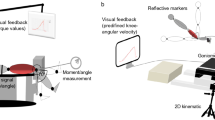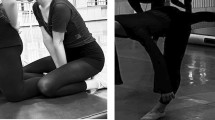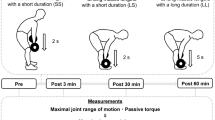Abstract
Purpose
To investigate the kinematic and muscle activation adaptations during performance of the Nordic hamstring exercise (NHE) to a 6-week eccentric hamstring training programme using the NHE as the sole mode of exercise.
Methods
Twenty-nine healthy males were randomly allocated to a control (CG) or intervention (IG) group. The IG participated in a 6-week eccentric hamstring exercise programme using the NHE.
Results
The findings of the present study were that a 6-week eccentric hamstring training programme improved eccentric hamstring muscle strength (202.4 vs. 177.4 nm, p = 0.0002, Cohen’s d = 0.97) and optimized kinematic (longer control of the forward fall component of the NHE, 68.1° vs. 73.7°, p = 0.022, Cohen's d = 0.90) and neuromuscular parameters (increased electromyographic activity of the hamstrings, 83.2 vs. 56.6 % and 92.0 vs. 54.2 %, p < 0.05, Cohen's d > 1.25) associated with NHE performance.
Conclusion
This study provides some insight into potential mechanisms by which an eccentric hamstring exercise programme utilizing the NHE as the mode of exercise may result in an improvement in hamstring muscle control during eccentric contractions.



Similar content being viewed by others
Abbreviations
- BF:
-
Biceps femoris
- CI:
-
Co-activation index
- CG:
-
Control group
- EMG:
-
Electromyography/electromyographic
- IG:
-
Intervention group
- MVC:
-
Maximum voluntary contraction
- NHE:
-
Nordic hamstring exercise
- POST:
-
Post-intervention
- PRE:
-
Pre-intervention
- RF:
-
Rectus femoris
- RPM:
-
Revolutions per minute
- ST:
-
Semitendinosus
- VL:
-
Vastus lateralis
References
Aagaard P, Simonsen EB, Andersen JL, Magnusson SP, Halkjaer-Kristensen J, Dyhre-Poulsen P (2000) Neural inhibition during maximal eccentric and concentric quadriceps contraction: effects of resistance training. J Appl Physiol 89:2249–2257
Arnason A, Gudmundsson A, Dahl HA, Jóhannsson E (1996) Soccer injuries in Iceland. Scand J Med Sci Sports 6:40–45
Arnason A, Andersen TE, Holme I, Engebretsen L, Bahr R (2008) Prevention of hamstring strains in elite soccer: an intervention study. Scand J Med Sci Sports 18:40–48
Blazevich AJ, Gill ND, Zhou S (2006) Intra- and intermuscular variation in human quadriceps femoris architecture assessed in vivo. J Anat 209:289–310
Blazevich AJ, Cannavan D, Coleman DR, Horne S (2007) Influence of concentric and eccentric resistance training on architectural adaptation in human quadriceps muscles. J Appl Physiol 103:1565–1575
Bourne MN, Opar DA, Williams MD, Al Najjar A, Shield AJ (2015) Muscle activation patterns in the Nordic hamstring exercise: impact of prior strain injury. Scand J Med Sci Sports. doi:10.1111/sms.12494 (Epub ahead of print)
Brockett CL, Morgan DL, Proske U (2001) Human hamstring muscles adapt to eccentric exercise by changing optimum length. Med Sci Sports Exerc 33:783–790
Brooks SV, Zerba E, Faulkner JA (1995) Injury to muscle fibres after single stretches of passive and maximally stimulated muscles in mice. J Physiol 488:459–469
Brooks JH, Fuller CW, Kemp SP, Reddin DB (2006) Incidence, risk, and prevention of hamstring muscle injuries in professional rugby union. Am J Sports Med 34:1297–1306
Daly C, McCarthy Persson U, Twycross-Lewis R, Woledge RC, Morrissey D (2015) The biomechanics of running in atheltes with previous hamstring injury: a case-control study. Scand J Med Sci Sports. doi:10.1111/sms.12464 (Epub ahead of print)
Ditroilo M, De Vito G, Delahunt E (2013) Kinematic and electromyographic analysis of the Nordic Hamstring Exercise. J Electromyogr Kinesiol 23:1111–1118
Fang Y, Siemionow V, Sahgal V, Xiong F, Yue GH (2001) Greater movement-related cortical potential during human eccentric versus concentric muscle contractions. J Neurophysiol 86:1764–1772
Faul F, Erdfelder E, Lang AG, Buchner A (2007) G*Power 3: a flexible statistical power analysis program for the social, behavioral, and biomedical sciences. Behav Res Methods 39:175–191
Freriks B, Hermens HJ (1999) SENIAM 9: European recommendations for surface electromyography. Results of the SENIAM project [CD-ROM]. Enschede, The Netherlands. Roessingh Research and Development. ISBN: 90-75452-14-4
Garrett WE Jr, Safran MR, Seaber AV, Glisson RR, Ribbeck BM (1987) Biomechanical comparison of stimulated and nonstimulated skeletal muscle pulled to failure. Am J Sports Med 15:448–454
Hawkins RD, Fuller CW (1999) A prospective epidemiological study of injuries in four English professional football clubs. Br J Sports Med 33:196–203
Hortobágyi T, DeVita P (2000) Favorable neuromuscular and cardiovascular responses to 7 days of exercise with an eccentric overload in elderly women. J Gerontol A Biol Sci Med Sci 55:B401–B410
Hortobágyi T, Hill JP, Houmard JA, Fraser DD, Lambert NJ, Israel RG (1996) Adaptive responses to muscle lengthening and shortening in humans. J Appl Physiol 80:765–772
Hortobágyi T, Devita P, Money J, Barrier J (2001) Effects of standard and eccentric overload strength training in young women. Med Sci Sports Exerc 33:1206–1212
Iga J, Fruer CS, Deighan M, Croix MD, James DV (2012) ‘Nordic’ hamstrings exercise—engagement characteristics and training responses. Int J Sports Med 33:1000–1004
Kellis E, Arabatzi F, Papadopoulos C (2003) Muscle co-activation around the knee in drop jumping using the co-contraction index. J Electromyogr Kinesiol 13:229–238
Kilgallon M, Donnelly AE, Shafat A (2007) Progressive resistance training temporarily alters hamstring torque-angle relationship. Scand J Med Sci Sports 17:18–24
Leonard JA, Brown RH, Stapley PJ (2009) Reaching to multiple targets when standing: the spatial organization of feedforward postural adjustments. J Neurophysiol 101:2120–2133
Lieber RL, Fridén J (2002) Mechanisms of muscle injury gleaned from animal models. Am J Phys Med Rehabil 81:S70–S79
Mann RV (1981) Kinetic analysis of sprinting. Med Sci Sports Exerc 13:325–328
Mendiguchia J, Arcos AL, Garrues MA, Myer GD, Yanci J, Idoate F (2013) The use of MRI to evaluate posterior thigh muscle activity and damage during nordic hamstring exercise. J Strength Cond Res 27:3426–3435
Mjølsnes R, Arnason A, Østhagen T, Raastad T, Bahr R (2004) A, 10-week randomized trial comparing eccentric vs. concentric hamstring strength training in well-trained soccer players. Scand J Med Sci Sports 14:311–317
Murphy JC, O’Malley E, Gissane C, Blake C (2012) Incidence of injury in Gaelic football: a 4-year prospective study. Am J Sports Med 40:2113–2120
Opar DA, Williams MD, Timmins RG, Dear NM, Shield AJ (2013a) Rate of torque and electromyographic development during anticipated eccentric contraction is lower in previously strained hamstrings. Am J Sports Med 41:116–125
Opar DA, Williams MD, Timmins RG, Dear NM, Shield AJ (2013b) Knee flexor strength and bicep femoris electromyographical activity is lower in previously strained hamstrings. J Electromyogr Kinesiol 23:696–703
Opar DA, Williams MD, Timmins RG, Hickey J, Duhig SJ, Shield AJ (2015) Eccentric Hamstring strength and Hamstring injury risk in Australian Footballers. Med Sci Sports Exerc 47:857–865
Orchard JW, Seward H, Orchard JJ (2013) Results of 2 decades of injury surveillance and public release of data in the Australian Football League. Am J Sports Med 41:734–741
Pasquet B, Carpentier A, Duchateau J (2006) Specific modulation of motor unit discharge for a similar change in fascicle length during shortening and lengthening contractions in humans. J Physiol 577(Pt 2):753–765
Petersen J, Thorborg K, Nielsen MB, Budtz-Jørgensen E, Hölmich P (2011) Preventive effect of eccentric training on acute hamstring injuries in men’s soccer: a cluster-randomized controlled trial. Am J Sports Med 39:2296–2303
Rhea MR (2004) Determining the magnitude of treatment effects in strength training research through the use of the effect size. J Strength Cond Res 18:918–920
Sale DG (1988) Neural adaptation to resistance training. Med Sci Sports Exerc 20:S135–S145
Seynnes OR, de Boer M, Narici MV (2007) Early skeletal muscle hypertrophy and architectural changes in response to high-intensity resistance training. J Appl Physiol 102:368–373
Thorborg K (2012) Why hamstring eccentrics are hamstring essentials. Br J Sports Med 46:463–465
van der Horst N, Smits DW, Petersen J, Goedhart EA, Backx FJ (2015) The preventive effect of the Nordic hamstring exercise on Hamstring injuries in Amateur soccer players: a randomized controlled trial. Am J Sports Med 43:1316–1323
Woods C, Hawkins RD, Maltby S, Hulse M, Thomas A, Hodson A, Football Association Medical Research Programme (2004) The Football Association Medical Research Programme: an audit of injuries in professional football—analysis of hamstring injuries. Br J Sports Med 38:36–41
Author information
Authors and Affiliations
Corresponding author
Additional information
Communicated by Toshio Moritani.
Rights and permissions
About this article
Cite this article
Delahunt, E., McGroarty, M., De Vito, G. et al. Nordic hamstring exercise training alters knee joint kinematics and hamstring activation patterns in young men. Eur J Appl Physiol 116, 663–672 (2016). https://doi.org/10.1007/s00421-015-3325-3
Received:
Accepted:
Published:
Issue Date:
DOI: https://doi.org/10.1007/s00421-015-3325-3




